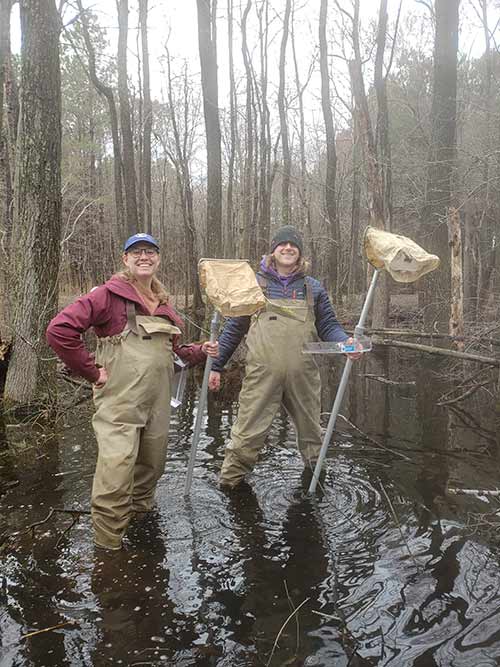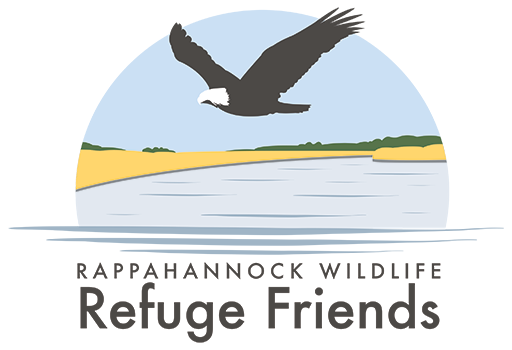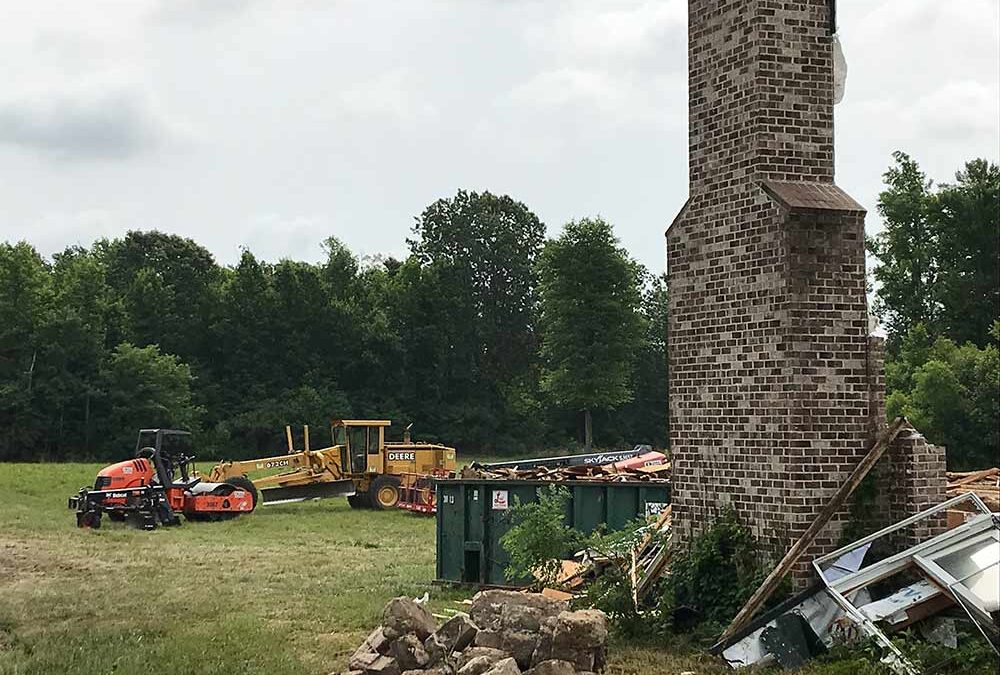 The Refuge staff has many projects ongoing at the Eastern Virginia Rivers NWR Complex. Six full time employees are responsible for the management of four refuges: Rappahannock River Valley NWR, Plum Tree Island NWR, James River NWR and Presquile NWR. Each refuge has its own purpose and niche. The many challenges of day to day management keep the Refuge staff and numerous volunteers very busy!
The Refuge staff has many projects ongoing at the Eastern Virginia Rivers NWR Complex. Six full time employees are responsible for the management of four refuges: Rappahannock River Valley NWR, Plum Tree Island NWR, James River NWR and Presquile NWR. Each refuge has its own purpose and niche. The many challenges of day to day management keep the Refuge staff and numerous volunteers very busy!
James River NWR has historically only been open to the public by special use permit. However, in 2019 staff and volunteers installed an ADA accessible canoe and kayak launch, and the very steep access road was improved to allow safe vehicular access. In the spring of 2020, parking lot construction will be complete along with a trail and corresponding signage and kiosks. The ribbon cutting for the new pubic use area will occur on Earth Day. James River is also in the process of writing a new hunt plan and opening additional hunting opportunities.
Presquile NWR has not had power for much of 2019, but James River Association and refuge staff persevered and kept the environmental education program running. This model partnership exceeded 10,000 students this year, reaching many schools and children in the Richmond area. The power line is currently being repaired, and the new Presquile NWR environmental education coordinator will be thankful to not regularly operate generators. Presquile NWR is also the recipient of a deferred maintenance project to upgrade the existing ferry landing. The project involves a boat purchase, dredging and barge retrofitting.
Plum Tree Island NWR, located near the City of Poquoson, is a former defense site and has many potentially unexploded ordinances. The Army Corps of Engineers is responsible for the unexploded ordinance clean-up. After a multi-year planning process approximately 20 million dollars has been allocated to the Corps by Congress to begin the cleanup. Refuge staff is coordinating closely with ACOE to assure refuge wildlife is protected during the clean-up, including the federally threatened tiger beetle and migratory birds.
I realize that many of you know us more as the Rappahannock River Valley NWR and things are not dull at the Rapp either. This fall our biologist designed and oversaw the start of an upland restoration project at the Tayloe tract in former farm fields. Approximately 1,000 trees were planted there. In addition, the Refuge has been working closely with Friends of Rappahannock (FOR) to complete additional future restoration. FOR received a large grant to conduct upland restoration and has selected over 100 acres on the Rappahannock River Valley NWR to plant trees over the next three years. The total project value will be just under $450,000 with the refuge contributing $30,000 over three years. This is a significant contribution to restoring our habitat and would take the refuge many more years to accomplish without FOR.
Lauren also continues to recruit biological volunteers to tackle kudzu and other invasive species, sample vernal pools, and conduct wildlife surveys. She will oversee a small cadre of interns this year including two interns hired to tackle invasive species as well as two interns who will be working on inventorying at-risk species. These interns will work all over the state of Virginia and not just on our Complex. There will be 16 of them across the Northeast Region, all housed at Refuges.
The newly acquired Fones Cliffs site now sports a new 1 ½ mile road and is missing two houses. Preliminary cultural resource work shows that Native American people may have lived at the location, and that many of the artifacts are in danger of falling into the river. Dr. Julie King and her crew, archaeologists from St. Mary’s College, will be returning to Fones Cliffs late this month to conduct more extensive surveys of the cliffs’ edge. This work will also clear the site for the installation of fence and an observation platform in preparation for eventually opening the tract to the public.
Work has also begun at the Belle Mount Tract. See article on Belle Mount Progress in this newsletter. The staff hope to offer a program open to the public in late summer or fall.
Members of a Maintenance Action Team (MAT), comprised of USFWS maintenance personnel from the region and financially supported by the Regional Office, are on the Refuge to complete the first phase of a deferred maintenance project. The goal of this deferred maintenance project is to remove almost 20,000 square feet of older buildings and barns, some of which have lead paint and/or asbestos contamination. The sites will be restored to native habitats following demolition.
Besides structures on the Belle Mount tract, facilities that are identified for demolition include some buildings on Hutchinson, an old barn at the Wilna office, and other older houses and barns on various Refuge tracts. The Laurel Grove staff quarters has also been identified for demolition. Staff is working on selling this house and some of the other infrastructure prior to demolition. Anything sold will have to be removed from refuge property.
As always, we could not tackle these projects without significant help from our Friends. We greatly appreciate all the support: building the fishing pier, removing old vineyard wire, preparing for Go Wild, and completing all the routine dedicated tasks you perform daily. Without your help these tasks simply would not be accomplished.
Contributed by Kendra Pednault


Recent Comments